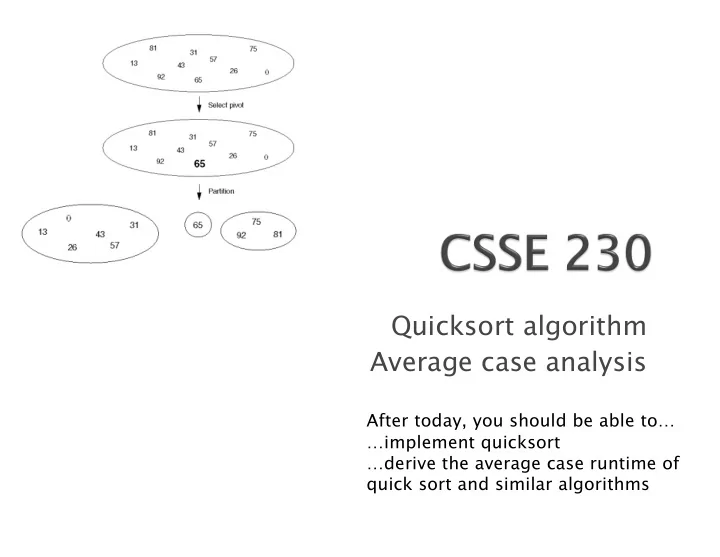

Quicksort algorithm Average case analysis After today, you should be able to… …implement quicksort …derive the average case runtime of quick sort and similar algorithms
Q1-3 Q1 For any recurrence relation in in th the f form : 𝑈 𝑂 = 𝑏𝑈 𝑂 + 𝜄 𝑂 ! , 𝑥𝑗𝑢ℎ 𝑏 ≥ 1, 𝑐 > 1 𝑐 The solution is: 𝜄(𝑂 "#$ ! % ) 𝑗𝑔 𝑏 > 𝑐 ! 𝜄(𝑂 ! 𝑚𝑝𝑂) 𝑗𝑔 𝑏 = 𝑐 ! 𝑈 𝑂 = 0 𝜄(𝑂 ! ) 𝑗𝑔 𝑏 < 𝑐 ! Theorem 7.5 in Weiss
} Side-by-side animations (now) www.sorting-algorithms.com } Others: ◦ Sounds of sorting (we’ll do next class) ◦ https://www.youtube.com/watch?v=kPRA0W1kECg ◦ Color wheel animations (later?) https://www.youtube.com/watch?v=y9Ecb43qw98
http://www.xkcd.com/1185/ Stacksort connects to StackOverflow, searches for “sort a list”, and downloads and runs code snippets until the list is sorted. For real: https://gkoberger.github.io/stacksort/
} Invented by C.A.R. “Tony” Hoare in 1961 } Very widely used } Guiding principle: ◦ Like in basketball, it’s all about planting a good pivot. A quote from Tony Hoare: There are two ways of constructing a software design: One way is to make it so simple that there are obviously no deficiencies, and the other way is to make it so complicated that there are no obvious deficiencies. The first method is far more difficult. Image from http://www.ultimate-youth-basketball-guide.com/pivot-foot.html.
Q4
Q5 Q5 // Assume min and max indices are low and high pivot = a[low] // will do better later… i = low+1, j = high while (true) { while (a[i] < pivot) { i++ } while (a[j] > pivot) { j–– } if (i >= j) break swap(a, i, j) } swap(a, low, j) // moves the pivot to the // correct place return j
} Let T(N) be the # of comparisons of array elements needed to quicksort N elements. } What is T(1)? } Otherwise T(N) is the sum of ◦ time for partition ◦ time to quicksort left part: T(N L ) ◦ time to quicksort right part: T(N R ) } T(N) = N + T(N L ) + T(N R ) } What’s the best case? What’s the worst case? } Write and solve each now!
} T(N) = average # of comparisons of array elements needed to quicksort N elements. } What is T(0)? T(1)? } Otherwise T(N) is the sum of ◦ time for partition ◦ av aver erag age time to quicksort left part: T(N L ) ◦ av aver erag age time to quicksort right part: T(N R ) } T(N) = N + T(N L ) + T(N R )
} Harder than just a single case…
Q8 Q8 } We always need to make some kind of “distribution” assumptions when we figure out Average case Assume that when we execute } k = partition(pivot, i, j) , all positions i..j are equ equal ally likel ely places for the pivot to end up } Thus N L is equally likely to have each of the values 0, 1, 2, … N-1 } N L +N R = N-1; thus N R is also equally likely to have each of the values 0, 1, 2, … N-1 } Thus T(N L )= T(N R ) =
Q9-10 Q9 10 } T(N) = } Multiply both sides by N } Rewrite, substituting N-1 for N } Subtract the equations and forget the insignificant (in terms of big-oh) -1: ◦ NT(N) = (N+1)T(N-1) + 2N } Can we rearrange so that we can telescope?
Q11-13 Q1 13 } NT(N) = (N+1)T(N-1) + 2N } Solve using telescoping and iteration: ◦ Divide both sides by N(N+1) ◦ Write formulas for T(N), T(N-1),T(N-2) …T(2). ◦ Add the terms and rearrange. ◦ Notice the familiar series ◦ Multiply both sides by N+1.
} Best, worst, average time for Quicksort } What causes the worst case? } We can guarantee we never hit the worst case ◦ How? ◦ But this makes quicksort slower than merge sort in practice.
} Avoid the worst case ◦ Select pivot from the middle ◦ Randomly select pivot ◦ Me Median of 3 pivot selection. (You’ll want this.) ◦ Median of k pivot selection } "Switch over" to a simpler sorting method (insertion) when the subarray size gets small Weiss's code does Median of 3 and switchover to insertion sort at 10. ◦ Linked from schedule page Wh What does the official Java Quicksort do? See the source code! (Search for “OpenJDK collections”, “OpenJDK Arrays”, etc.)
Th The partition on cod ode I gave you ou has 2 2 bugs: 1. 1. It It can walk off the end of the array 2. 2. If If the chosen pivot is duplicated, it can go into an infinite recurs re rsion (st stack overflow) // Assume min and max indices are low and high pivot = a[low] // can do better i = low+1, j = high while (true) { while (a[i] < pivot) i++ while (a[j] > pivot) j-- if (i >= j) break swap(a, i, j) } swap(a, low, j) // moves the pivot to the // correct place return j
Recommend
More recommend